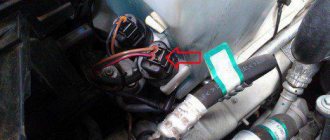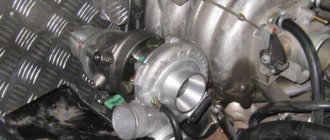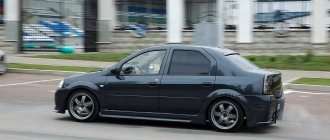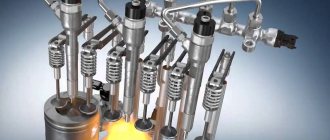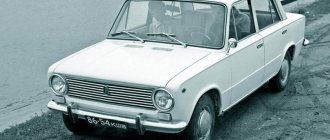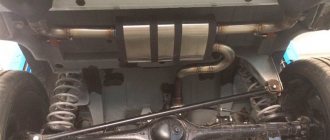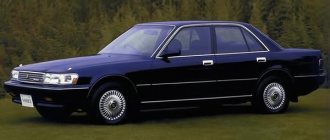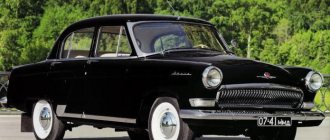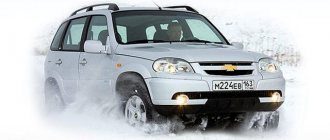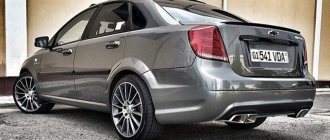Any reconstruction of an engine in order to improve its performance is a complex work, based on a clear idea of what we want to get, how to do it, and whether it can be done at all. Here it is impossible to do without knowledge of the working processes occurring in the engine. It is also necessary to understand that everything in the engine is interconnected: a change in one unit leads to a change in the entire working process - from the air intake to the exhaust pipe cut. Moreover, in different modes, any intervention has a different effect: what is good in one mode may be bad in another.
We usually consider torque and power to be the main characteristics of an engine. It is these that they strive to increase by tuning the engine. This can be done using two main methods. The first way is to increase the torque on the crankshaft. The second is to move it to the high speed zone without touching the torque value.
Increased torque
Engine tuning kit
Torque is practically independent of crankshaft speed, but is determined only by engine volume and cylinder pressure. Everything is clear with volume - the more, as far as the engine design allows, the better. The pressure can be increased by increasing the compression ratio. True, there are few reserves here - the capabilities of this method are limited by detonation. You can approach it from the other side. The more air-fuel mixture we “drive” into the engine, the more heat, obviously, will be released during its combustion in the cylinder and the higher the pressure in it will be. This is true for naturally aspirated engines.
The second option applies to the supercharged engine family. By changing the characteristics of the control unit, you can slightly increase the amount of boost, which will make it possible to remove more torque from the crankshaft.
And the third option - to achieve better filling of the cylinders by improving gas dynamics - is the most common and the most... not guaranteed. The idea is that you need to do something with the channels and the combustion chamber... But everything is in order.
Working volume. One of the main options is to increase the cylinder displacement as much as possible. Within reasonable limits, of course. For a road car, this approach is the most correct, because by increasing the volume without changing the camshaft, i.e. By leaving the torque curve in the same rpm range as it was, the driver will not need to relearn his driving style. And at the end we get what we are looking for - a more dynamic car.
The working volume can be increased in two ways - by replacing the standard crankshaft with a crankshaft with a large eccentricity or by boring the cylinders for larger diameter pistons. It is logical to ask what is more effective and what is less expensive. After all, what is engine volume: it is the product of the piston area and its stroke. Having, relatively speaking, doubled the diameter, we quadrupled the area. Because it's squared.
And by doubling the stroke, we only double the volume. That's the math. Now about the economics of the issue. At first glance, it seems that replacing the crank mechanism is less expensive than boring the block to a larger size. The caveat is that a crankshaft with a large eccentricity still needs to be found. They are made to order by rare companies; production is expensive and complex. In this case, it is reasonable to rely on the standardization of the manufacturer. Therefore, it is logical to buy a serial product, in our case a crankshaft, and select a piston group for it. Of course, other pistons and connecting rods will be needed.
It's difficult, but you can find it. The question is different. Structurally, such a move introduces additional mechanical losses in engine operation, the culprit of which will be shorter connecting rods. This is an axiom - if we install a crankshaft with a large eccentricity, we will have to install shorter connecting rods, because we will not be able to increase the block. What is their disadvantage? The shorter the connecting rod, the greater the angle it “breaks”, the more force it presses the piston against the cylinder wall. And the greater the pressing force, with the same coefficient of friction, the greater the amount of movement resistance. And this factor should be considered not only from the point of view of mechanical losses, but also from the point of view of reliability, because short connecting rods are subject to heavy loads.
In tuning, as a rule, such “little things” are neglected. When you can’t, but really want to, then you can. An obvious benefit in terms of minimizing costs is increasing the displacement by increasing the cylinder diameter. As a rule, all engines have a fairly thick cylinder wall, a safety margin. If, say, you increase the diameter by two millimeters, you can get additional volume. With a wall thickness of 7-8 mm, one millimeter can be sacrificed. And quite often you can get by with serial pistons. True, it is impossible to unequivocally state that increasing the cylinder diameter is cheaper than replacing the crankshaft. It is reasonable to consider each of these two methods from the perspective of the specifics of a particular engine.
Supercharged technologies. The family of turbocharged engines is interesting for tuning due to its design features, which greatly simplify engine tuning. In our case, it is possible to obtain a larger torque, again without touching either the torque curve or the volume, and without even disassembling the engine, only slightly changing the amount of boost.
What are the design features of supercharged engines? First of all, in the features of compressor control, be it a turbine or a mechanical compressor. The boost pressure of both the first and second depends on the number of engine revolutions. The more revolutions, the higher the pressure. But it can only be increased up to a certain amount. The control unit monitors this, releasing excess pressure. By changing its characteristics, i.e. By slightly raising the bar for this same bleeding, we will increase the pressure with which the fuel-air mixture is “clogged” into the cylinder volume. And it actually clogs up a larger volume than in the case of “gentle” parameters on a production engine.
Work to increase pressure is not painless - serial engines have a certain margin in mechanical and thermal loads, and in detonation resistance. It is possible to increase the boost within reasonable limits. But if you go overboard, then in order not to break the engine, you will have to resort to additional modifications - increase the volume of the combustion chamber, change the cooling system, install an additional radiator, air intakes, and an intercooler. You will probably have to replace the cast-iron crankshaft with a steel one, select stronger pistons and provide them with cooling.
Changes in gas dynamics. The essence is clear - in order to get more torque, you need to increase the charge of the fuel-air mixture. What can be done? You can take a tool and remove defects in serial assembly - make the intake and exhaust channels smoother and more even, eliminate ledges and sharp corners at the junctions of parts, remove unblown zones in the combustion chamber, replace valves and seats. There is a lot of work, but there is no guarantee. Why?
Aerodynamics is not an easy thing. It is difficult to mathematically describe the processes occurring in the engine. It’s hard to take a pen and paper and make calculations and, based on the results, trim something, cut it, bend it... Or “take an eye” and say where there is something superfluous... Sometimes the result is exactly the opposite of what was expected or none at all. To be fair, it must be said that there are reserves in aerodynamics. But they can be reliably extracted only by performing a series of experiments, blowing through plasticine mock-ups of the intake channels in a special installation, selecting their shape and cross-section in accordance with the requirements of the new engine operating conditions. It is unlikely that this can be done “on the knee”.
Sequence of chip firmware without modification of the ECU
Everything here is still quite simple. After the necessary programs and drivers are installed on the computer, the adapter block is connected to the diagnostic port. The ignition must be turned off. Next, the laptop starts and the ignition is turned on. After this, Flasher is launched and errors that need to be fixed are selected. After the errors are removed, launch a new file with the firmware and wait until the setup is completed. Only after everything is completed, turn off the ignition, wait at least 5 minutes and turn on the ignition again. See what Flasher throws at you. If after setting up errors occur again, the procedure should be repeated.
After everything is completed, we start the engine and see how the car works. If everything is fine, then the firmware procedure is completed.
Power increase
Sports camshafts
What is power? This is the product of torque and engine speed. Thus, by shifting the standard torque characteristic to the high speed zone, we will obtain the desired increase in power. The downside is that the engine doesn’t run well at low speeds.
Any gas distribution mechanism (without a variable phase mechanism) allows you to fill the cylinders well only in its speed range. And as soon as we move the torque to the higher rpm region, we immediately lose it at the bottom. At low levels, the cylinders will be poorly ventilated, but for an ordinary road car this is bad - we press on the gas, but it doesn’t move. The driver must keep the needle in the high speed zone. Moving away means burning the clutch. Therefore, all production engines have a maximum torque somewhere in the range of a reasonable 2-3 thousand, so that nothing falls through below.
Of course, modern engines with variable valve timing do not suffer from such failures. At low speeds, with the help of a control mechanism, the phases become narrow, the overlap (the duration of the simultaneous opening of the intake and exhaust valves) is small, and at low speeds the cylinders are well filled.
As soon as this engine gets into the high speed zone, the phases expand, the overlap increases, the cylinders begin to vent well at high speeds, and we have good torque.
So, if we have a traditional engine (without variable phases), we can tell ourselves: we don’t care about low speeds, we put a wide-phase camshaft in the engine, thereby allowing us to have good filling in the high speed zone. True, it is unlikely that we will get a large torque; most likely, we will get the same absolute value as the serial one, only in the high-speed zone.
But its product multiplied by the speed at which it is achieved will be significantly greater than that of a production engine, therefore the power is higher. The engine will have a pronounced sporting character. The resulting power can only be used by adjusting the gear ratios in the transmission. This is the way that is used in sports.
Another way to increase engine power is to reduce mechanical losses. It is possible to reduce losses due to overcoming friction forces in the cylinder-piston group by a number of measures: reducing the mass of the pistons and connecting rods, reducing the size of the piston skirt and the thickness of the piston rings, moving the location of the connecting rod fixation from the axial displacement to the piston bosses, etc.
In addition, it is also important to reduce oil splashing by the crankshaft by specially directing the oil drained from the cylinder head, installing oil reflective screens, etc. True, these measures are mainly effective at high speeds, when losses to overcome friction are especially high.
Reducing friction force
You can also quite well increase the number of “horses” if you reduce the friction force between the piston and the cylinder walls. Of course, there is motor oil for this, but as a rule it is not enough, so various additives are used. Can I recommend the Suprotec additive, about which there are a lot of rumors; some are not sure how it works. Someone says that it really works, we belong to the second type of people and recommend this additive. In principle, you don’t have to trust us and use some other additive from another manufacturer, it’s your choice.
Using this method, you can achieve about a 7% increase, and also improve the reliability of the engine due to the fact that the friction force of the piston on the cylinder walls will be less. There is also a rumor that this additive reduces fuel consumption, but we have not tested this and will not confirm this rumor.
From theory to practice
So, we have found out the basic principles. Let's now try to choose a scheme according to which we can boost the engine. Obviously, the first thing to decide is how much to increase the volume of the cylinders. If the goal is to achieve maximum effect when boosting, then volume cannot be neglected, even if we do not have many possibilities at our disposal: increasing power and torque is directly proportional to the volume of the cylinders. The next most important thing is the valve timing.
It is necessary to make a choice: are we “building” a “high-speed” engine that will “spin” at high speeds, or a “torque” one that will operate at medium speeds. This no doubt depends on the driver's temperament and riding style. At this stage, we have to select a camshaft for our engine - it is the shaft parameters that determine the nature of the change in torque and power based on the crankshaft rotation speed. All tuning camshafts can be divided into two groups: low and high. Based on the name, the former increase the torque in the low engine speed range, and the latter – in the high speed range. This is achieved by changing the lift height and profile of the cams, as well as the opening/closing phases of the valves.
The lower shafts have a low lift height and no valve overlap zone, which prevents the mixture from being thrown back into the intake at low speeds. Reducing the lift height entails an inevitable loss of filling at high speeds, which leads to a decrease in the maximum engine power. However, this is not so important, since their main area of application is driving around the city. The main advantage of such shafts is an increase in low-end torque, which allows you to accelerate noticeably faster from a traffic light and avoid having to downshift once again.
Top shafts, on the contrary, have wide phases, high lifts and a fairly large valve overlap area. This makes it possible to increase filling at the top, both due to an increase in the flow area in the valve area, and through the use of the inertial boost effect. At the same time, engine power almost always increases, and the peak torque shifts to a higher speed zone. Wide phases lead to the mixture being pushed back into the intake manifold at low speeds, which causes a decrease in filling and a dip at the bottom. The higher the camshaft, the stronger this effect.
Split gear
It is also recommended to install the so-called split gear - a Werner pulley, which allows, without changing the belt tension, to shift the valve timing, that is, the opening and closing moments of the intake and exhaust valves with high accuracy, while a standard gear allows you to do this with an accuracy of one tooth, which is not enough to get a good result.
Then all components and parts of the engine are “adjusted” to the engine size, but most importantly, to match the selected camshaft. In other words, the entire valve mechanism, intake and exhaust channels, cylinder-piston group - everything is “adapted” to the characteristics of the camshaft. Whatever engine the result turns out to be, it will be a new, different engine. And they need to be managed differently. That is, in a different way, but accurately regulate the composition of the fuel-air mixture and the ignition timing. Therefore, the next stage of work is setting up the engine control system (chip tuning). Without this, the new engine will not only not “give out” all its capabilities, but may lose to its standard counterpart. This is especially true for engines with electronic fuel injection systems. (More about chip tuning).
In addition, tuning the engine will inevitably entail a number of activities, such as working with the transmission, suspension, and brakes. Theoretically, and practically, engine power can be increased quite significantly, but the question is whether this measure is reasonable, because sooner or later the car itself will structurally cease to correspond to its power unit. There is a certain limit that limits the weight distribution of a car, the coefficient of adhesion of its tires to the road. There is simply no point in revving up the engine and, as a result, simply firing the clutch, burning rubber and crumbling CV joints.
Differences between engines and their tuning
The difference is the air supply to the fuel system. There are atmospheric and equipped with special supercharged pumps. Accordingly, tuning an atmospheric engine is more labor-intensive and requires the installation of additional equipment. Therefore, for naturally aspirated engines, it is advisable to perform turbo tuning in order to automate the process of dosing air into the fuel.
Firstly, the best engine for tuning is the one that you won’t mind tinkering with, replacing entire parts. Secondly, preferably with turbines. And thirdly, it is always a money issue. Availability of financial resources decides the whole process.
https://www.youtube.com/watch?v=_4ozjkC5faY
Nitrous oxide
Kit for installing nitrous oxide
In cases where an increase in power and torque is required only for a short period of time, a simpler alternative to mechanical tuning is used - nitrous oxide N2O (nitros). Nitros is the best choice for those who do not want to spend a lot of money, but still want to achieve a significant increase in engine power.
Mechanical tuning implies direct mechanical intervention in the operation of the engine, alteration of its components and assemblies. This, in turn, reduces engine life or leads to very expensive replacements of parts such as cylinder blocks, pistons, connecting rods, crankshafts, camshafts, valves, etc. The nitrooxide system (NOS) is turned on at the driver's request, and the rest of the time the engine operates in its normal mode without additional loads and fuel consumption.
Where does the increase in power come from? The density of nitrous oxide is approximately 50% greater than the density of air. Oxygen in it is about 36% (versus 21% in the atmosphere). That is, during the decomposition of nitrous oxide, 1.7 times more oxygen is released than is found in the same volume of air. To supply the portion of nitrous oxide necessary for instant acceleration into the cylinders, you do not need a turbine or a drive compressor - it is enough to let the liquefied gas from the cylinder into the intake manifold. This is what they do during acceleration by opening the gas line valve using a remote drive.
Once in the engine, nitrous oxide molecules break down into nitrogen and oxygen under the influence of high temperatures, and this released oxygen allows gasoline to burn more efficiently. The pressure in the cylinder increases, and as a result, an increase in power. And the released nitrogen works as an anti-knock agent, preventing the combustion process from proceeding like an avalanche.
Nitrous oxide also increases the density of the air-fuel mixture. Nitrous oxide supplied to the mixture in the form of liquefied gas leads to its immediate cooling, because the temperature of the evaporating liquefied gas is always several orders of magnitude lower than the ambient temperature. And as we know, a cooler, denser mixture burns better and produces more power.
Types of Nitrous Oxide Systems
There are three types of nitrous oxide systems – the so-called “dry”, “wet”, and direct port systems.
- The “dry” system is the cheapest and simplest; nitrous is supplied to the manifold by one nozzle. The system is uncontrollable; it can only be turned on and off. An additional nozzle for supplying nitrous is embedded under the carburetor or into the manifold behind the air filter (for injection engines). Fuel injection is carried out as usual. That's the problem. When supplying nitrous oxide, you need to supply more fuel. Otherwise, the mixture will become leaner, and unwanted detonation will occur, which may well lead to engine failure. And since the injection is controlled by the on-board computer, you have to either reconfigure it, increasing the duration of opening of the injectors, or increase the pressure in the fuel line.
- The “wet” nitros system is a more advanced device. Nitrous is supplied in the same way as in a “dry” one, but additionally fuel is supplied using a separate nozzle, which allows you to avoid detonation and achieve maximum performance for this type of injection. The volume of nitrous oxide and fuel is adjusted by the nitro system computer, which makes this device more independent and easy to control. The only difficulty is that such a system has to be connected to an additional fuel line. Such systems are especially suitable for supercharged engines.
- The third type of nitrous oxide injection systems is direct injection systems. Here, a separate nozzle is provided for each cylinder, which, at the command of the distribution block, mixes and measures the required amount of nitrous oxide and fuel. Thus, it is possible to control the nitrous oxide/fuel ratio for each cylinder individually. This is the most powerful and one of the most accurate types of systems. Direct injection systems are also the most difficult to install. Due to this, as well as their high power, these systems are mainly used on racing cars.
All these joys are overshadowed by some risk. All the scary stories about melted pistons and burned out engines are backed up by facts. As long as you install a relatively low-power NOS (nitrooxide system), there is nothing to fear. The main thing is to choose the right kit for a given engine. 4-cylinder engines allow you to get an additional 40-60 hp, 6-cylinder engines allow you to get an increase in the range of 75-100 hp, a small block V8 - up to 140 hp, a large block V8 - 200 hp. With. This is the recommended increase in power, allowing you to leave the engine mechanics without modification.
If this is too little for you, then you will need to tune the engine quite a bit. First - replacing the connecting rod and piston group. It is necessary to use forged pistons instead of stock ones due to the increased load on the engine. Next comes replacing the crankshaft and adjusting the ignition system. It is also necessary to use high-quality fuel or special racing gasoline. Often a larger fuel pump and cooler spark plugs are required.
Why do we all need this?
The term chip tuning implies optimization (improvement) of engine programs. Simply put, nothing bad will happen to your car. If you need more detailed information, Google is always ready to help you. And now I will highlight only the main advantages of this process.
The advantages of chip tuning include:
- increased opportunities for acceleration when overtaking on roads where there is heavy traffic;
- provides significantly more comfortable driving on city streets thanks to slightly increased traction and speed characteristics;
- chip tuning is a faster and easier way to tune a car engine compared to boosting the engine;
- possibility of easier movement when the vehicle is fully loaded
- fuel economy.
